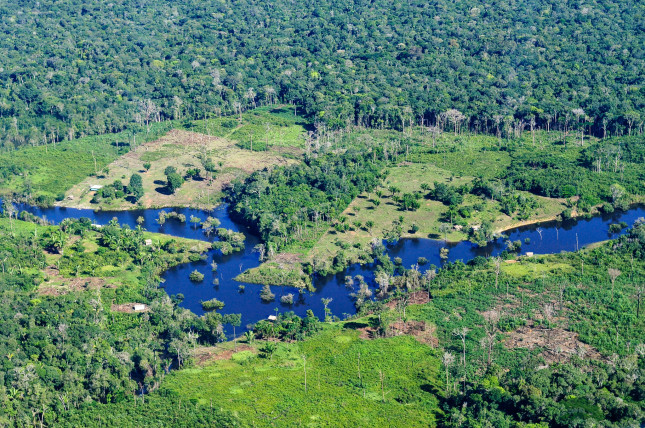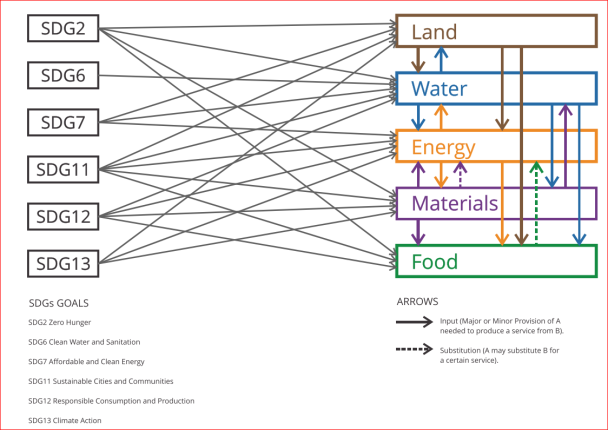-
Resource Nexus Approaches Can Inform Policy Choices

The unabated growth of natural resource consumption raises risks that we will outstrip the capacities of ecosystems and governance institutions. At the same time, to achieve important global goals related to poverty alleviation, public health, equity and economic development such as those embodied in the United Nations Sustainable Development Goals (SDGs), we will simultaneously need more resources and better management of natural resources everywhere.
Achieving the UN’s Sustainable Development Goals will require successful efforts to better integrate resource management across local, regional and global scales if greater ecological degradation, erosion of livelihoods and threats to security are to be avoided. Can resource governance be substantially improved across and between multiple types of resources, and become integrated with SDG implementation?
Resource Nexus
Debates about increasing and interconnected natural resource consumption, waste, and governance are often framed in terms of a “resource nexus.” We define the resource nexus as a set of context-specific critical interlinkages between two or more natural resources used in delivery chains in systems that provide water, energy, food, land, and materials. These dynamic chains involve complex social relations across scales and time, posing significant governance challenges. If “nexus” is to be more than an buzz word, as Nature suggested, approaches invoking the concept must add analytical clarity and apply to governance.
Past resource governance focused mostly on single resource categories such as water or energy in a supply chain running from primary natural resource, through processing and distribution to final consumption and disposal. The nexus concept is a response to this kind of siloed thinking. It emphasizes the importance of examining critical interlinkages across resources.
Our recent article in Nature Sustainability presents a five-node concept of the resource nexus and a set of analytical methods, modelling approaches, and scenarios for assessing system implications and capturing the dynamics for existing interlinkages and for future strategies, as well as building knowledge about these interdependencies. We argue that multi-scale, polycentric resource governance and assessment, in dialogue with various modelling efforts, can inform policy choices in the public, private, and civil society sectors.
Five Interlinked Resource Sets
A large and growing group of analysts and authors from around the world have been discussing nexus approaches since at least 2011. Our nexus approaches explore interlinkages between five resource sets: water, energy, food, materials, and land. Seeking improved assessment and governance of these links is critical if the SDGs on zero hunger (SDG 2), clean water and sanitation (SDG 6), affordable and clean energy (SDG 7), sustainable cities and communities (SDG 11), responsible consumption and production (SDG 12), climate action (SDG 13), and sustainable use of terrestrial ecosystems (SDG 15) are to be achieved. For example, water resources are centrally important not only for SDG 6 (clean water and sanitation), where it is the explicit subject, but also for SDGs 2 (zero hunger), 7 (affordable and clean energy), 11 (sustainable cities and communities), and 12 (responsible consumption and production).
If water-focused actors, policies, and initiatives seek to achieve SDG 6 without reference to the water-related needs of other SDGs, they may miss opportunities and contradictions. And impediments to SDG achievement would likely to increase. The same holds true for land, food, materials, and energy if you enter inter-resource connections and SDG implementation planning via any one of these resource sets.

Benefits of Focussing on Interlinkages
Systems thinking is foundational. Researchers and practitioners can start from a broad nexus understanding but may well focus on certain critical interlinkages. Assessment tools such as lifecycle analysis, value chain management, and scenario development and modelling approaches are available to reduce waste and increase efficiencies—sometimes through recapture and reuse—and establish critical resource thresholds to signal major risks of exceeding the capacities of ecosystems and governance institutions at various scales or within sectors. Such tools can potentially link various governance efforts to reduce the ecological and humanitarian costs of mining or agriculture, and simultaneously improve supply chain management and SDG implementation.
Integrated approaches could be better applied to address multiple targets and achieve greater sustainability across public and private sectors and at various levels of scale. And, in the process, such approaches could improve the decidedly uneven and incomplete resource-related monitoring, data gathering and analysis that currently exists across scales.
Modelling and scenario techniques are particularly good for exploring potential future implications for current choices and practices; and helping to identify and visualize demand, supply, and other governance challenges. The five-node nexus can be adapted to specific contexts and should help to focus on the most relevant resource interlinkages across layers. It can also help us further explore interlinkages with biosphere integrity and circular economy, which involves a vision of sustainable resource use that moves beyond the current take-make-dispose extractive industrial model and takes waste out of the equation.
In short, each SDG cannot be achieved in isolation and all SDGs have explicit or implicit resource-related demands and implications. In a world of scarce resources of all kinds—including time—we must prioritize assessment, planning, and governance initiatives that simultaneously maximize and integrate much more sustainable resource management and SDG implementation.
Stacy D. VanDeveer is Professor of Global Governance and Human Security at University of Massachusetts Boston’s McCormack Graduate School of Policy and Global Studies.
Raimund Bleischwitz is Chair in Sustainable Global Resources and Director of the Bartlett School of Environment, Energy and Resources at University College London.
Catalina Spataru is Associate Professor in Global Energy and Resources and Head of the Islands Laboratory at the Energy Institute, University College London.
This article is adapted from “Resource nexus perspectives towards the United Nations Sustainable Development Goals” in Nature Sustainability.
Sources: Ellen MacArthur Foundation, Nature, Nature Sustainability, Routledge Handbook of the Resource Nexus by VanDeveer et al.
Photo Credits: Aerial view of the Amazon Rainforest, near Manaus, the capital of the Brazilian state of Amazonas, April 2011. Photo by Neil Palmer/CIAT, courtesy of CIFOR.
Topics: agriculture, development, energy, environment, featured, food security, Guest Contributor, land, minerals, natural resources, water
 A Publication of the Stimson Center.
A Publication of the Stimson Center.




